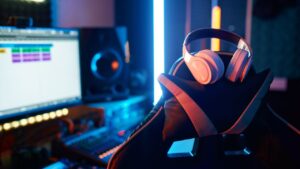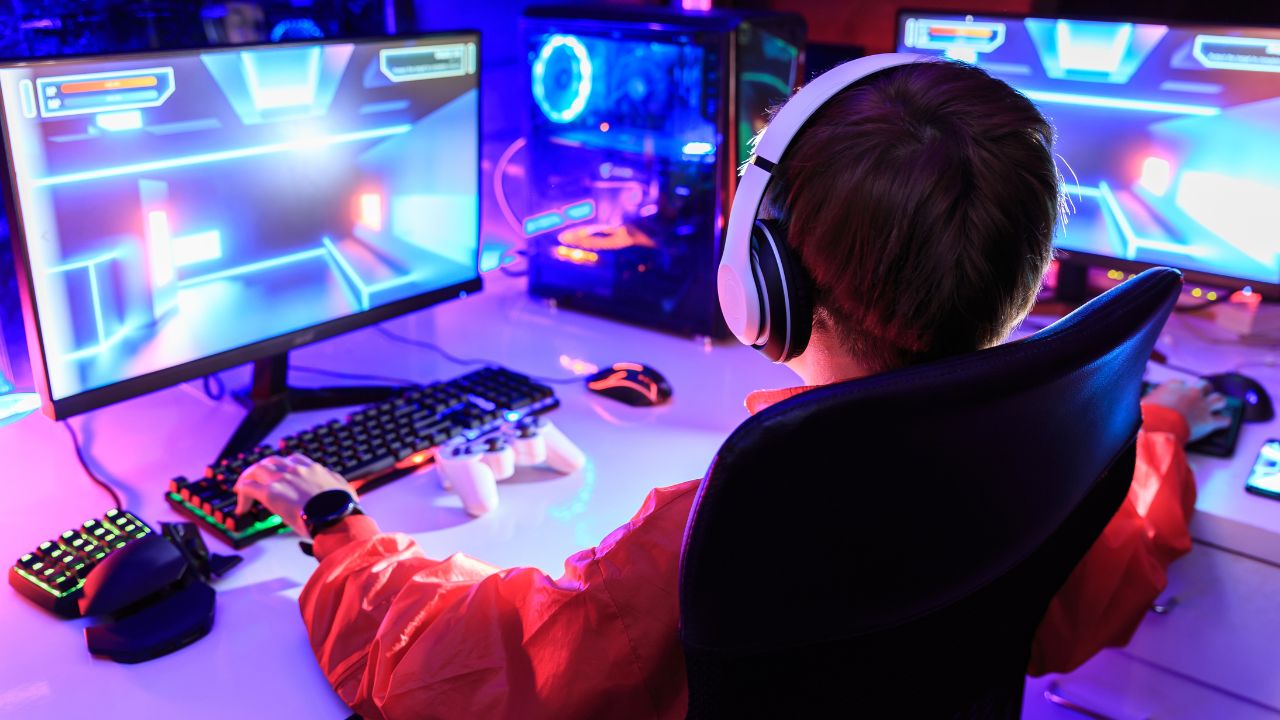SelfDesign learners entering grade 12 who have enjoyed the Virtual Dreamers and Life Gamified themes offered to grade 10 and 11 learners now can continue their explorations of digital media. SelfDesign rolled out the new Game On! theme last year. Of the theme’s three courses, one allows learners to delve into computer information systems, and another, into music composition and production.
“We developed Game On! as a direct result of learner demand,” says Educational Programs team lead Janice Green. “It came through our learner surveys, which we send out at the end of each semester. One of the things that came up repeatedly in their responses was the need and desire for continuing the digital media–related offerings that are available through grade 12.”
Educator Michael Bender, the learning specialist who leads the grade 10 and 11 digital media themes, facilitates GameOn! Former SelfDesign Principal Nikki Kenyon developed the theme’s computer information systems course. Learning consultant and musician Eden Poynter developed the music composition and production course.
“I was thrilled to be a part of these offerings,” Michael says. “They represent my love of music and technology, so it was definitely heartwork for me. The learners I had this year were enthusiastic about the new theme. They are the ones who made the courses come alive, and they amazed me with what they created and shared.”
 Designing a computer information systems course for SelfDesign
Designing a computer information systems course for SelfDesign
“I’m a math nerd, and I own it proudly,” Nikki says, “My first university degree is in math and computer science, and my original intention was to become a math teacher, so high school math and computer courses are dear to my heart. I’m also very familiar with the format of our grades 10 to 12.”
As with all courses offered at SelfDesign, the BC Ministry of Education and Child Care specifies the general content, competencies and Big Ideas that a course needs to include. Those provided the general course framework for Nikki to create learning opportunities that have meaning for learners.
“It’s quite fun to write curriculum,” Nikki says. “You get to dive deep into the topic and look at it with your learner hat on to see how the topic can be made most effective, supportive, interesting, engaging and actually have meaning for learners.”
Some of the ministry’s stated competencies deal with critical thinking. For the course, Nikki chose to focus on the competencies around critical thinking related to technology. The first modules encourage learners to consider what user-centred design is and what it looks like. Another module prompts learners to look more deeply at new technology development today and research what it is meant to do, why it was developed, and whether it may have any unintended consequences.
“This course feels really important because we’re right on the edge of a technological revolution, with the advent of artificial intelligence and where that’s headed,” Nikki says. “There are many benefits associated with it and many risks, and we don’t really know yet what that will look like. Much of the course is about understanding, designing and building computer networks, but before the learners get to that, the course encourages them to think critically about the unintended consequences of technology design.”
The course works with a free, downloadable software package called Cisco Systems that sets up a sample, or dummy, network for users. Users can then work in a network without actually having a network. This levels the playing field for all learners taking the course who need to be able to apply some of the skills that they’re learning.
“The more exposure we can get in an online school to these standard kinds of software packages, the better,” Nikki says. “Our learners are not sitting in a classroom where the network is on the lab computers and where the learning is happening together in real time. We had to find a creative way for our learners to engage actively with the software and with the principles and practise the skills they’re learning in a virtual, online way.”
 Music comes to SelfDesign’s offerings
Music comes to SelfDesign’s offerings
Eden Poynter joined SelfDesign as a learning consultant for learners in kindergarten to grade 9 five years ago. She has a degree in music education. She reads and writes music. She plays guitar and sings in the Victoria-based band, West My Friend, and has recorded multiple albums.
“I was really happy when SelfDesign asked me to develop this course,” she says. “Every human culture and society creates and communicates with music. It’s a thing that humans do and love to do, and I feel including music as part of education addresses an essential part of what it is to be human.”
For several years before the COVID pandemic, SelfDesign offered a week-long summer musical Jam Camp. The GameOn! music composition and production course is the school’s first structured music-focused offering.
“It was fun thinking about how I could make music accessible and meaningful to learners with a great range of musical knowledge and experience,” she says. “Learners can do the course without knowing how to read music or what scales or chords are, and those with deeper knowledge can take the weekly challenges and discussions really far, as well. Learners can do anything from creating rhythms using pots and pans in their kitchen to recording a sonata they wrote on their cello. The whole range is welcome and possible.”
 Courses in SelfDesign’s grades 10 to 12 are set up for diversity in learner backgrounds. For each weekly challenge — what SelfDesign calls assignments — in a grade 10 to 12 course, learners are free to explore a topic to different levels. The first level, called “Discover,” exposes learners to a topic and encourages them to try things out in a structured, supportive environment. The Follow-the-Steps level allows learners to dig more deeply into a topic. With the Personalize level, learners can choose from a suite of options to personalize the topic and make it meaningful to them.
Courses in SelfDesign’s grades 10 to 12 are set up for diversity in learner backgrounds. For each weekly challenge — what SelfDesign calls assignments — in a grade 10 to 12 course, learners are free to explore a topic to different levels. The first level, called “Discover,” exposes learners to a topic and encourages them to try things out in a structured, supportive environment. The Follow-the-Steps level allows learners to dig more deeply into a topic. With the Personalize level, learners can choose from a suite of options to personalize the topic and make it meaningful to them.
And true to the digital media aspect of GameOn!, the new music composition and production course requires learners to use a digital audio workspace. Different suggestions and guidelines are provided to help learners set themselves up with free or paid options available online. Once that’s done, Eden says, “If they want, learners can then use electronics, looping and samples, instead of creating all the sound themselves on an instrument.”
Videos and resources cover musical elements and terms, such as rhythm, beat, tempo, notes, melody, harmony, tonality, and so on. The course balances emotional and creative expression with technical learning. It also provides opportunities to learn about the music of diverse cultures, including Indigenous content and perspectives, to think about sounds, rhythms and elements authentic to their own communities, and to avoid cultural appropriation.
Eden also set out to use the course to expand learners’ definitions of music.
“Learners may legitimately like or dislike some of the recordings provided in the challenges, but it is important that they listen to them with open ears,” she says. “It’s so easy to shut ourselves off from things we don’t like and to think that we can’t get anything from them. Liking or disliking something is entirely separate from learning from something or appreciating something, and I think that’s a good thing for people to hold in their lives, not just when they’re thinking about art and music.”
Read more about how SelfDesign uses learner feedback to improve its learning offerings>
Read about grades 10 to 12 at SelfDesign>
Learn about the kindergarten to grade 9 Minecraft group>
Read more about Michael Bender, digital media learning specialist>

